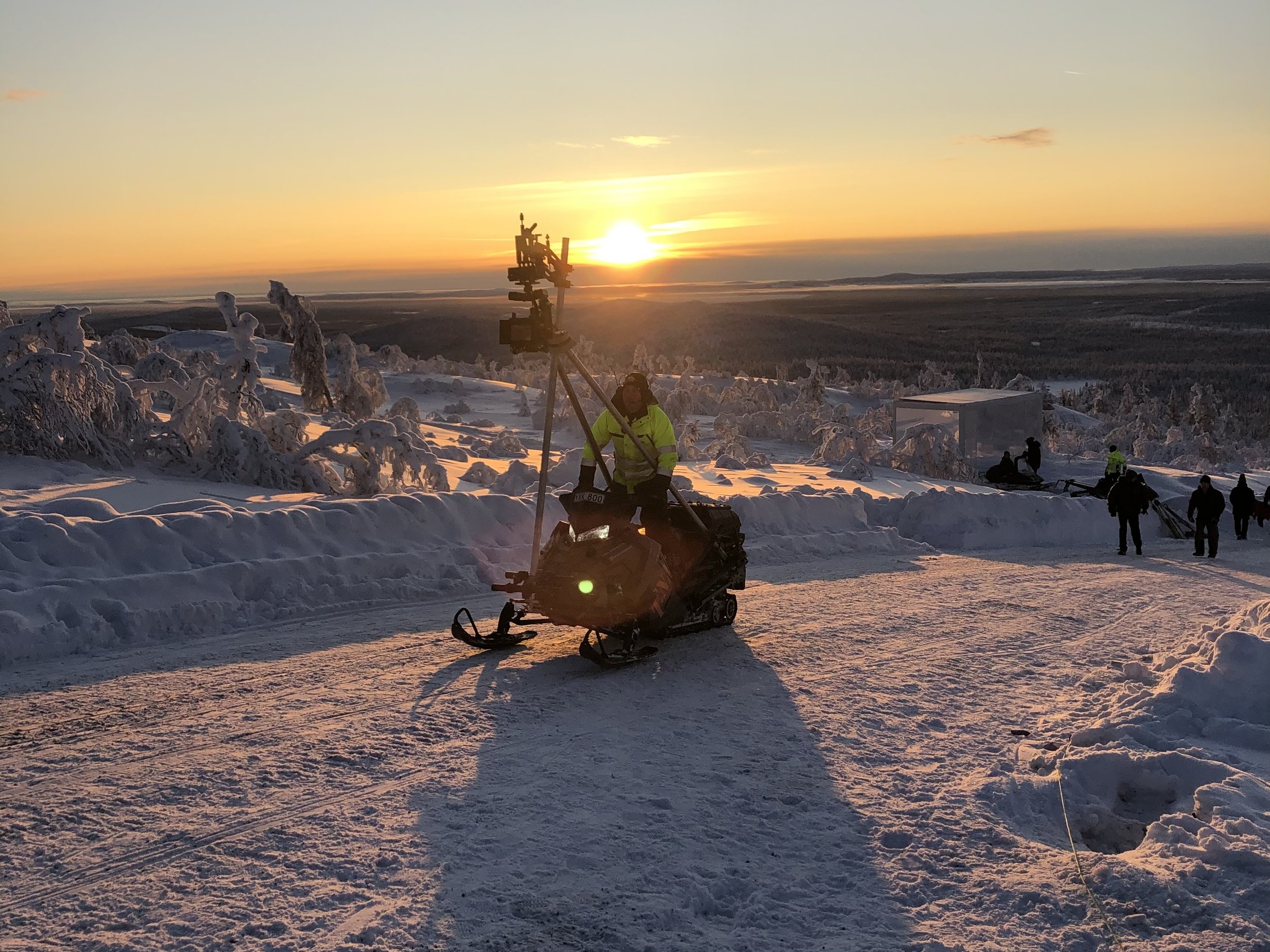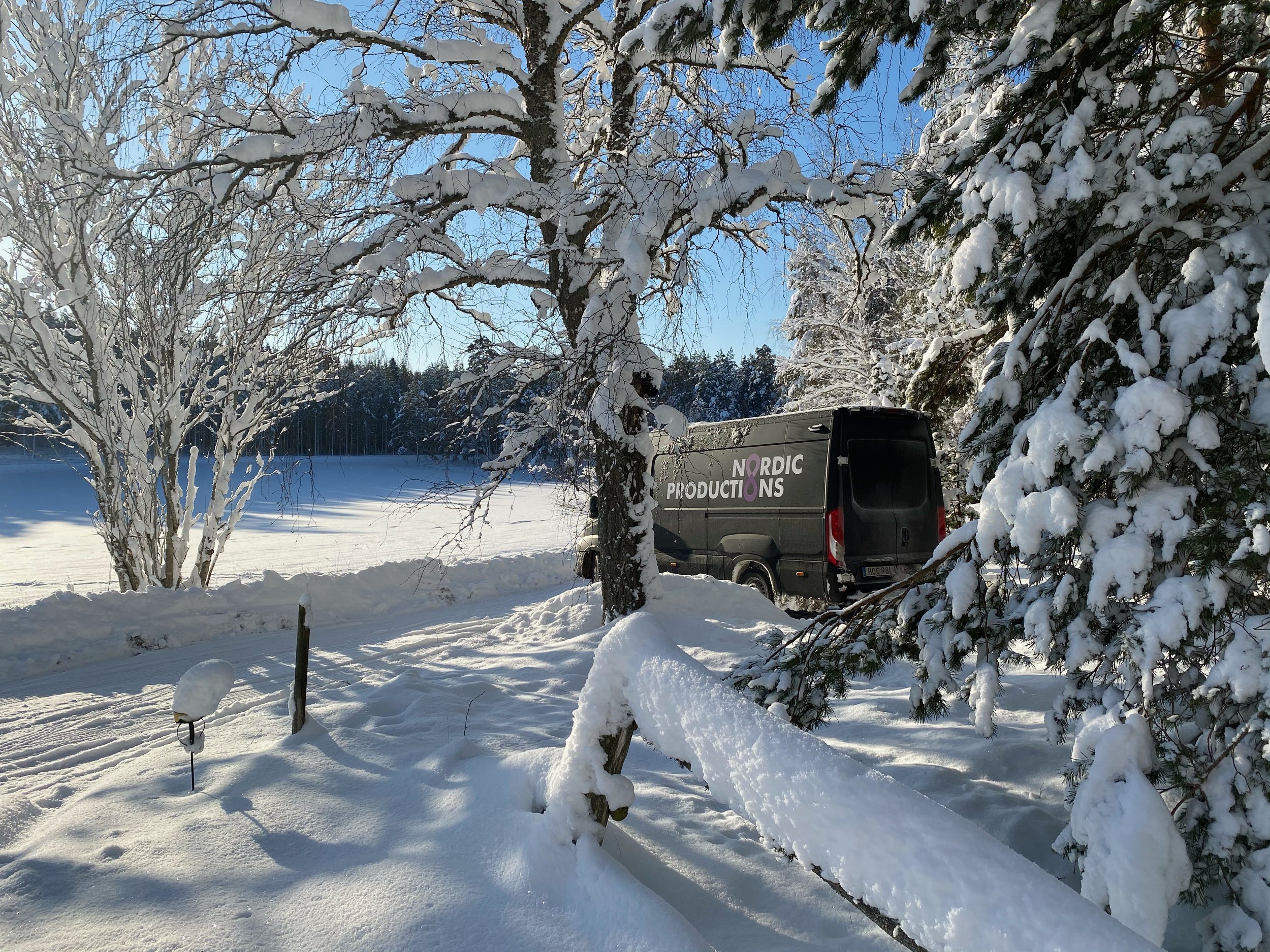FILMING IN THE COLD
How do you keep yourself & your gear warm, safe & secure when the temperature drops way below zero?
HEAD TO TOES
Winter in the northern parts of Scandinavia lasts anywhere from five to eight months, depending on weather conditions and location. But no matter where you are, it rarely rises above freezing from December to March. Clothing may be optional in the sauna, but not when you’re working in the cold.
The easiest way to stay warm is with different layers. The colder it is, the more layers you should wear. It is also important to have a very warm hat and something to protect your neck from the cold air. You lose most of your body heat through your head.
When traveling by foot or skis you don’t need so many layers, because you generate so much body heat from the movement, but if you stop you should have an extra warm jacket to put on. When traveling on a snowmobile, try to wear a windbreaker for your outer layer. Also, try to cover your face with a balaclava as well as possible, so the wind factor won’t freeze your face.
Moisture can be a real nightmare for productions moving in and out of cold and warm spaces.
Keeping dry in cold temperatures is very simple. Just don’t go inside when you are full of snow. That way, it doesn’t melt and wet your clothes. If you are moving a lot and start to sweat, then you just take one or two layers away. The important thing is to keep your feet, hands and head warm and dry with good gear. If you start sweating, change into dry clothes. If you start to feel cold, move a little to generate body heat.
There is a chance of getting wet in the cold too: you might sweat or get wet from the snow. This calls for moisture-wicking materials that keep you warm even when damp. First, avoid cotton in every layer. Cotton is not only uncomfortable but also potentially dangerous in freezing temperatures, especially against the skin. Cotton will get wet, stay wet and eventually make you cold. Try comparing wool and cotton yourself, and you’ll see the difference.
Merino wool is very much the perfect material for winter socks, underwear, the first layer and your beanie too. Wool keeps you warm and transfers moisture away from the body. It works. Even when wet. Thin wool garments will work like a charm in warmer weather too. If you want to avoid animal products, synthetic performance materials that mimic the qualities of wool make a good substitute.
2. DRIVE SAFE
When the temperature drops, the world gets slippery, and a million YouTube videos are born. But the northern parts of Scandinavia has modern and maintained infrastructure, and that includes the roads, streets and highways. All winter long, from the first snowflake to the last, snowplows and snow gritters keep the roads clear and drivable.
No one likes to get pulled over for misunderstanding or being ignorant of the law. Here’s a handy list to remember, whether it’s winter, summer or somewhere in between -
• Use your headlights at all times.
• Wear a seatbelt, even in the backseat.
• Drive on the right-hand side of the road.
• Follow the posted speed limits.
• Don’t drive under the influence of drugs or alcohol.
• Don’t use your phone while driving.
When autumn cools and the long dark days of winter approach, nighttime temperatures often drop below freezing, especially on road surfaces. When driving in autumn (and sometimes late spring), pay attention to the road surface and watch out for black ice. It might look like water or a dry road, but it’s frozen.
Ice on the roads is a real possibility, but what about when the locks on your car doors freeze? Not to worry. You can purchase a de-icer to free up your lock, and use the mechanical key on your fob to get inside.
But you still have millimeters of ice covering every window surface. Don’t become an Internet viral video by throwing boiling water on your windshield. More likely than not, you’ll be paying for a new windshield. Instead, grab your ice scraper and apply elbow grease. Scraping takes a little time, but it won’t damage your windshield. Don’t forget to gently free your wipers and scrape the ice off those as well. If there’s snow, you’ll probably spend a few minutes brushing your car. Plan for it.
As semi-wild reindeer make their way back to their home pastures during the autumn migration, it’s pretty common to see them foraging on the side of the road. Be warned: Both Sweden and Finland are reindeer countries, and they often will ignore you or walk on the road in front, behind or beside you. Elk, on the other hand, are the rhinoceroses up here in the north, big and cantankerous. They are completely wild, meaning they can attack when threatened. If you come across an elk, stop immediately! Do not take photos or videos. Just wait for the elk to go about its business.
From December 1st to March 1st, all cars must have studded winter tires. If you’re driving from somewhere else, be aware that it’s not just a good idea to have studded tires—it’s the law. Above all, always drive carefully—studded tires aren’t magic.
3. FROST ON FILM, NOT ON YOUR LENS
Northern Scandinavia may be an accessible and convenient place to go, but don’t forget some parts are still part of the Arctic. Understanding the conditions and necessities help make your production smoother and more comfortable.
Here comes some advice for anyone bringing a camera to some of the colder places -
Keep cameras and other equipment in boxes and in luggage when not needed. Remember to close the lids and the zippers!
When filming, we recommend using winter covers for the cameras when it’s cold or snowing. So the snow doesn’t melt into cameras afterward. When it’s rainy or moist, use a rain cover. Or get an umbrella and an assistant! You can also use chemical heaters next to the batteries or beside the camera to generate more heat.
You can save battery life with a ”reverse cooling bag.” Put sealed warm water bottles into the battery bag so that the bag becomes a warm bag. This way, the batteries will last longer.
When you stop shooting DO NOT place the camera directly on the snow. Place it in a bag or on a box. Afterward, you need to clear all metal parts of snow that they don’t start to rust. After the shoot, leave cameras on floors or tables. Don’t leave them sealed in bags; moisture won’t leave the bags.
When you go from the cold outdoors to warm inside, moisture can build up inside the camera. Put the camera in a plastic bag outside, and go inside slowly. Let the moisture dry. Or you will have a foggy lens (all the lenses inside of the lens) for hours. You can always accelerate the drying with a hairdryer. It really works!
The winter in Scandinavia is nothing to be afraid of. We can help you, no matter the conditions!





